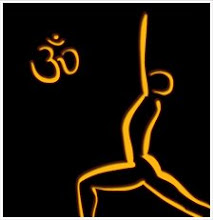
The primary series of ashtanga yoga, yoga chikitsa meaning yoga therapy, consists mainly of forward bending postures. It is not an unusual position to be in and most of us are much more familiar with folding forward, while tying our shoelaces or lifting fallen objects from the ground, than its reverse, bending backward. However, we often bend our knees on our way down to, say, pick something up, instead of allowing the backs of the legs to become fully stretched, leaving the movement unfulfilled, and thus many of us have tightness in the hamstrings and the hips.
During a forward bend, the upper body is flexed forward with the backs of the legs and the back muscles being stretched. Anatomically, most of the movement in a forward bend takes place in the hips and the lumbar region, that is the lower back area above the sacrum, as well as the sacral region of the spine. The traditional and originally taught method of forward-bending by Sri K. Pattabhi Jois is to simply fold forward, relax the head, round the back, tuck the tail bone in and avoid flaring the sit-bones up and away. This makes engaging mula bandha and uddiyana bandha possible and is a perfect example of how ashtanga yoga is more about integrating the energy (into the mula/uddiyana region) rather than ‘spacing-out’ and dispersing the flow of energy. The straight-back (flat-back) approach makes engaging mula bandha and uddiyana bandha almost impossible and has a certain disconnective effect.

This division or separation is also very common in downward-facing dog when the feet are too far away from the hands. If the student is encouraged to step the feet further forward then not only is the pose more stable (the heels drop to the ground) but the bandhas become more easily connected and the flow of energy is working correctly. One other effect of a strong uddiyana bandha is to protect the lower back by stabilizing the entire region, and actually encourages the lower back to open more safely and deeply rather than strain the area by using the flat-back approach. Its not about what it looks like! Have a look at the 1950s pics of Pattabhi Jois to see how the master intended it!
Forward bending stretches not only the backs of the legs, but also the back, arms and shoulders. It is often encourages to engage the quadriceps muscles during a forward bend as this further relaxes the hamstrings, allowing a deeper pose. It also makes the legs strong and is beneficial for the knees. The form which the body takes in a forward bend resembles the position of a foetus in the uterus. The vertebrae become separated which stimulates the nerves that run along the spinal cord. Thus forward bending indirectly benefits the overall health of the practitioner.

If uddhiyana bandha, lower stomach lock, is held firmly, forward bending has a strong effect on the internal organs, especially the spleen, kidneys, liver, abdomen and reproductive organs, massaging them and providing alleviation for digestive organs. During the primary series, the body is repeatedly folded forward which encourages heat in the entire body and stimulates digestion. Combined with uddhiyana bandha, forward bending postures tone the abdominal muscles. Hatha Yoga Pradipika says about the seated forward bending posture:
“Paschimottanasana is the best among asanas. By this asana the pranic currents rise through sushumna, the digestive fire increases, the abdomen becomes flat, and the practitioner becomes free from disease.”
(p. 93)
Sources:
Asana, Pranayama, Mudra, Bandha bihar School of Yoga, 1996 edition.
Hatha Yoga Pradipika, Bihar School of Yoga, 1998 edition.
Coulter, D. H., 2001 Anatomy of Hatha Yoga USA: Body and Breath Inc.
